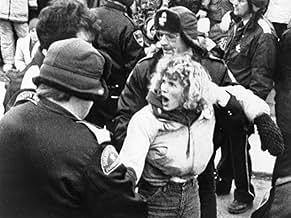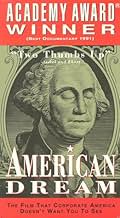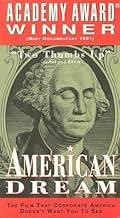IMDb रेटिंग
7.8/10
1.1 हज़ार
आपकी रेटिंग
अपनी भाषा में प्लॉट जोड़ेंRecounts the 1985-86 strike against the Hormel Foods Corporation in Minnesota after its employees' wages and benefits were cut.Recounts the 1985-86 strike against the Hormel Foods Corporation in Minnesota after its employees' wages and benefits were cut.Recounts the 1985-86 strike against the Hormel Foods Corporation in Minnesota after its employees' wages and benefits were cut.
- 1 ऑस्कर जीते
- 12 जीत और कुल 3 नामांकन
Dan Rather
- Self
- (आर्काइव फ़ूटेज)
Ronald Reagan
- Self
- (आर्काइव फ़ूटेज)
फ़ीचर्ड समीक्षाएं
10jgtoms
This film is absolutely stunning. It centers around union meatpacking workers at a Hormel plant in Austin, Minnesota in the mid-80's. The trouble started when Hormel cut worker pay from $10.69 an hour to $8.25 an hour. The problem? Hormel had just posted a net profit of $30 million. As one worker at a union meeting put it, "If we have to take a cut of $2.45 an hour when the company just made $30 million, I hate to think of what's gonna happen when they actually post a loss." With no help from their parent union, International Food and Commercial Workers Union, the local union (P-9) goes on strike alone trying to bring Hormel to its knees. Director Barbara Kopple, who also made the great "Harlan County, USA", does an outstanding job of capturing every important moment. She has the camera there at every union meeting, press release, Hormel press release, etc. She also shows the very personal aspects of a strike going into people's homes and showing their innermost feelings about what's going on. In the end, the strike is long, drawn out, and things appear bleak. The constant Minnesota cold, snow and ice are always in the background as well. If one doesn't have a greater appreciation for unions and what they have to sometimes endure after watching this film, he/she probably didn't pay very good attention.
I was raised in a beef slaughtering plant family in Northeastern Colorado. My father was a member of UFCW Local 7 for many years as well as my brothers and my mother. Watching this movie brought back memories of how life was during strike time. I will hand it to Kopple, about catching the true realities of a plant family on strike. The scenes of the negotiation teams and plant management were excellent, since I didn't get to see what happens behind closed doors, there were guys that told me, but it really hits home when you see it. The scenes of the slaughter, even though my family worked in beef plant and this was a hog plant, I could hear the noise and smell the smells and oddly enough, it was like being back home. This movie brought some tears to my eyes and some bittersweet memories...please e-mail if you have any questions about what life is like on strike...
Barbara Kopple's American Dream is a painful but honest on all sides look at what labor unions have to go through when they go into strike- mode, and how corporations, starting in the 80's, say the unions flaws in negotiating as a means to get in to change things for their benefit. It's that kind of movie though that doesn't discriminate in a key way - I think if you're pro-union or anti-union even, you can get something out of this take by how Kopple presents everything. The characters here all want what's best, but it's not so simple as'let's negotiate a contract'. Sides become fractured, tempers get flared, and a 'labor consultant' arguably muddies the waters early on in the negotiating. By the time it gets to be many weeks into the strike, some of the folks on the picket lines get desperate, cross and go back to work, and the sides become even more fractured.
It's about the Hormel meat-packing district, but the staying power of the film is this: it could be anywhere. Is it just about if wages decrease by two dollars, or four dollars, or about something more when it comes to bargaining, the rights of workers, and who is really in control? The interviews and perspective are in large part on Lewie Anderson, who probably has the most common sense as we can see it (or rather in comparison with the Consultant Ray Rogers, who is technically a corporate guy as well), and how he has to approach the union and the chief committee about where to go with Hormel - and of course the flaws are there, like rewriting the contract that has forty years of bargaining in it for the rights of the workers.
This is not to say that, for the warts-and-all approach Kopple takes, that she is on the side of the corporate masters at Hormel. We see one of their spokesman, who is a down-the-line party guy, talk to the camera(s) with the candor that one expects from such a corporate man about dealing with the union leaders (maybe not as villainous as, say, a Roger Smith from Roger & Me, but what is). But it's mostly there, in those halls and on the picket lines and in those smokey, emotional offices that Kopple takes her sights and tells this story. How it becomes a tale for almost everyone (not to say that, probably, those who have worked in unions or know people who have, that makes up a good lot of Americans, will connect deeper with it) is that it's not about complex legal wrangling. It's about what people do when pushed up against a wall, and put themselves into a war.
It is a complicated tale to tell, that is without easy answers, but by the end you can't say you don't see how things did not turn out well, especially with the greater picture (albeit not shown really or at least on the level of the 'smaller-but-bigger' picture the director paints) that the country was in at the time, and still are. What happens to these Americans, all hard workers, when faced against corporate pressures, and then other workers are brought in across the picket lines. What happens to society?
It's about the Hormel meat-packing district, but the staying power of the film is this: it could be anywhere. Is it just about if wages decrease by two dollars, or four dollars, or about something more when it comes to bargaining, the rights of workers, and who is really in control? The interviews and perspective are in large part on Lewie Anderson, who probably has the most common sense as we can see it (or rather in comparison with the Consultant Ray Rogers, who is technically a corporate guy as well), and how he has to approach the union and the chief committee about where to go with Hormel - and of course the flaws are there, like rewriting the contract that has forty years of bargaining in it for the rights of the workers.
This is not to say that, for the warts-and-all approach Kopple takes, that she is on the side of the corporate masters at Hormel. We see one of their spokesman, who is a down-the-line party guy, talk to the camera(s) with the candor that one expects from such a corporate man about dealing with the union leaders (maybe not as villainous as, say, a Roger Smith from Roger & Me, but what is). But it's mostly there, in those halls and on the picket lines and in those smokey, emotional offices that Kopple takes her sights and tells this story. How it becomes a tale for almost everyone (not to say that, probably, those who have worked in unions or know people who have, that makes up a good lot of Americans, will connect deeper with it) is that it's not about complex legal wrangling. It's about what people do when pushed up against a wall, and put themselves into a war.
It is a complicated tale to tell, that is without easy answers, but by the end you can't say you don't see how things did not turn out well, especially with the greater picture (albeit not shown really or at least on the level of the 'smaller-but-bigger' picture the director paints) that the country was in at the time, and still are. What happens to these Americans, all hard workers, when faced against corporate pressures, and then other workers are brought in across the picket lines. What happens to society?
It may at times resemble an illustrated Bruce Springsteen protest ballad, but the tragedy in Barbara Kopple's Oscar winning documentary portrait of a Minnesota meat packer's strike is too rich to ignore, not unlike the film 'Roger & Me' but without Michael Moore's self-serving humor. The story begins in the mid 1980s, when the Hormel Company in Austin, Minnesota, tried to lower wages despite showing a healthy profit, leading members of Local P-9 to ignore their parent Union and hire an rhetoric spouting outside agitator (labor 'consultant' Ray Rogers), who transformed their grievance into a noble but ultimately self-defeating grassroots crusade. Kopple herself remains more or less invisible throughout the film, but her sympathy for the renegade P-9 underdogs (and her anti-Reaganomics attitude) is obvious, and she reveals the personal and civic consequences of labor disunion with heartbreaking clarity. The strike itself may not have made headlines outside the Mid West, but the story has some devastating implications for organized labor nationwide, and beyond that supplies enough drama and character to match any Hollywood blockbuster.
Remaining in obscurity, this is another Union strike documentary from director Barbara Kopple, the brilliant filmmaker who brought us the landmark masterpiece documentary "Harlan County, USA", this time chronicling a strike of meat-packers in Austin, Minnesota -- around the time where Reagan put the clamp down on Unions, with his decision to fire the striking air-traffic controllers. Is it as great as "Harlan County, USA"? No. Is it worth seeing? Most definitely, especially for those who were fans of the previously mentioned film, for while it is not on the same level, American Dream is a very fine film in its own right, bringing some more interesting things to the table.
It starts a little slow, and I am not sure how relevant the film remains today, but it slowly becomes more and more absorbing. If Kopple's previous film, 14 years earlier, was a profound documentation of the power of the working class and the success of the Unions and people working together -- then "American Dream" is a documentary about the FAILURE of the Unions. This is a rather bleak film, augmented by the shots of the snow-covered, frozen land of Minnesota winter, giving the film at times a very cold mood. I would say that this film, although obviously taking sides with the strikers, is fairly even-handed. More importantly, however, it shows the major divisions in the Unions in how to achieve their goals and how to avoid the worst outcome, which is everyone losing their jobs and in essence being crushed by the companies.
As in "Harlan County, USA", the film is at its best when dealing with individual dramas and human moments between the people. While Kopple does offer some occasional narration and an added musical score, her presence is often unseen, allowing the people to tell the story, with the drama ultimately being created by the film's editing. We essentially see how the people of the Union, from the top down, are basically torn apart as their cause becomes more and more hopeless. How people of the community have to pick between crossing the picket line and reviving their job, or keeping their promises and integrity to the Union and to the community. We see people in heated arguments, we see people in brawls, best friends against best friends, brothers against brothers. There are some fantastic moments of drama. Like in "Harlan County, USA" where we feel the overwhelming feeling of a people united, standing up against the powers that be, here we see it all crumbling and falling down. For this alone it, it makes "American Dream" very much so worth seeing, as it is works as a very interesting continuation of Kopple's previous film, only 14 years later, and this time the vision of the American worker and the community it creates is only ever more bleak.
It starts a little slow, and I am not sure how relevant the film remains today, but it slowly becomes more and more absorbing. If Kopple's previous film, 14 years earlier, was a profound documentation of the power of the working class and the success of the Unions and people working together -- then "American Dream" is a documentary about the FAILURE of the Unions. This is a rather bleak film, augmented by the shots of the snow-covered, frozen land of Minnesota winter, giving the film at times a very cold mood. I would say that this film, although obviously taking sides with the strikers, is fairly even-handed. More importantly, however, it shows the major divisions in the Unions in how to achieve their goals and how to avoid the worst outcome, which is everyone losing their jobs and in essence being crushed by the companies.
As in "Harlan County, USA", the film is at its best when dealing with individual dramas and human moments between the people. While Kopple does offer some occasional narration and an added musical score, her presence is often unseen, allowing the people to tell the story, with the drama ultimately being created by the film's editing. We essentially see how the people of the Union, from the top down, are basically torn apart as their cause becomes more and more hopeless. How people of the community have to pick between crossing the picket line and reviving their job, or keeping their promises and integrity to the Union and to the community. We see people in heated arguments, we see people in brawls, best friends against best friends, brothers against brothers. There are some fantastic moments of drama. Like in "Harlan County, USA" where we feel the overwhelming feeling of a people united, standing up against the powers that be, here we see it all crumbling and falling down. For this alone it, it makes "American Dream" very much so worth seeing, as it is works as a very interesting continuation of Kopple's previous film, only 14 years later, and this time the vision of the American worker and the community it creates is only ever more bleak.
क्या आपको पता है
टॉप पसंद
रेटिंग देने के लिए साइन-इन करें और वैयक्तिकृत सुझावों के लिए वॉचलिस्ट करें
- How long is American Dream?Alexa द्वारा संचालित
विवरण
- रिलीज़ की तारीख़
- कंट्री ऑफ़ ओरिजिन
- आधिकारिक साइट
- भाषा
- इस रूप में भी जाना जाता है
- Американская мечта
- फ़िल्माने की जगहें
- उत्पादन कंपनियां
- IMDbPro पर और कंपनी क्रेडिट देखें
बॉक्स ऑफ़िस
- US और कनाडा में सकल
- $2,69,823
- US और कनाडा में पहले सप्ताह में कुल कमाई
- $9,291
- 22 मार्च 1992
- दुनिया भर में सकल
- $2,69,823
इस पेज में योगदान दें
किसी बदलाव का सुझाव दें या अनुपलब्ध कॉन्टेंट जोड़ें






















